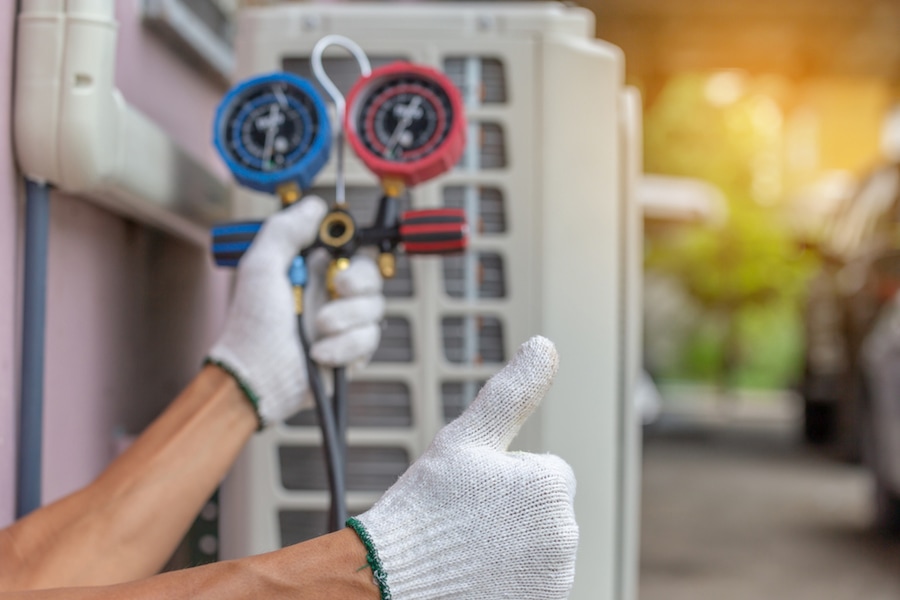In the picturesque landscapes of California, where sustainability is more than just a buzzword, the integration of green building practices

When upgrading/ installing your home’s HVAC sizing and design system, there are many things you need to consider. This includes the cooling and heating capacity needed to keep your house comfortable.
The overall size of the HVAC system should closely match the size of your home. Otherwise, you’ll end up wasting money and energy. Unfortunately. Most homeowners are still buying oversized or undersized systems for their homes. This can be a major problem for your home’s energy efficiency and overall comfort. Therefore, systems should be sized in a way that allows them, to fulfill their function.
In this article, we’ll look at some dangers associated with improperly sized HVAC.
To understand the meaning of an oversized system, you need to know how its capacity is measured. Furnaces are measured in BTUs (British Thermal Units). This refers to the amount of energy that can increase the temperature of 1 pound of water by 1° F.
On the contrary, air conditioning devices are rated in tone. 1 tone of nominal cooling is equivalent to 12,000 BTUs. Therefore, a 4-ton air conditioner has a cooling capacity of about 48,000 BTUs.
Every home needs a certain amount of cooling & heating capacity for optimal comfort. If the HVAC system has a higher capacity as compared to your home’s size, it’s considered oversized. For instance, let assume your house only need 15,000 BTUs of cooling & heating capacity. If the HVAC system generates triple or even double that capacity, it’s oversized!
Installing larger systems on the harshest winters or hottest summers may sound brilliant. The truth, however, is that you’ll end up with expensive repairs later on. Moreover, you’ll experience other problems like;
Oversized HVAC systems can cool or heat your house faster. However, this speed can cause other issues like making the indoor temperature uncomfortable. For instance, if the system is too large, it will cycle off and aggressively. This will make the living space feel too warm in one moment and too cold the next. As a result, it will be uncomfortable to be inside the rooms.
Air conditioning units lower your home’s humidity levels, especially in humid areas. Sadly, a wrong size unit cannot maintain the ideal humidity levels.
An air conditioner draws air into the device, passing it through an evaporator coil. Here, the coil condenses any moisture from the air. The formed water droplets then move into a condensate. Consequently, your home’s humidity level decreases.
If the air conditioning unit is too big, it will not run long enough to cool the room. Therefore, it will not end up eliminating water vapor in the air. This will increase your home’s humidity levels. As a result, the room becomes uncomfortable and clammy for most people.
An oversized HVAC system increases energy bills and decreases efficiency. For instance, AC units have motors that need the power to run elements like the blower and compressor. If the motors are too big, they’ll need more power to start up as compared to running the components. This will eventually lead to an increased utility bill.
A machine that works harder tends to wear down prematurely. The same case applies to HVAC systems. If an AC or heater has the excessive capacity, it turns off and on regularly. This exposes its components to unnecessary wear & tear and reduces their lifespan.
With the proper maintenance, an average home HVAC unit can last for about 15 – 20 years. However, most systems don’t live that long because of HVAC design and sizing issues.
An oversized system blasts the living space with cool air. However, an effective system is supposed to cool down the room moderately. These temperature fluctuations make the HVAC system shut down and startup rapidly. This condition is commonly referred to as ‘short cycling’.
If left unchecked, short cycling can damage your home’s HVAC system. The constant stopping and starting cause unnecessary wear and tear on various components. This includes; blower fan motor, compressor, and other elements. For this reason, you’ll end up replacing your unit sooner than expected.
Sometimes, homeowners install AC units that are way too small for their home This also leads to capacity issues and can have serious problems. For instance, a smaller AC runs constantly in an attempt to keep up with the thermostat settings. They will wear down different parts of your system. Not to forget that it will not heat or cool your work or living space effectively. More importantly, you’ll have to pay high energy costs than you would if the system was properly sized.

Conclusion
As you can see, poor HVAC sizing and design can compromise your system in various ways. Therefore, proper sizing, design, and installation will ensure the efficiency of your HVAC system.
To find the perfect HVAC unit size for your home, start by calculating the living pace’s square footage. Also, consider factors like the number of floors and the building’s insulation. These elements will form a single component known as “load”, measured in BTUs/ hour.
To learn more about this, reach out to HVAC pros at Innodez Design and Engineering today! We’ll calculate your home’s square footage and consider those factors to find the ideal HVAC size for your home.
About Author
InnoDez